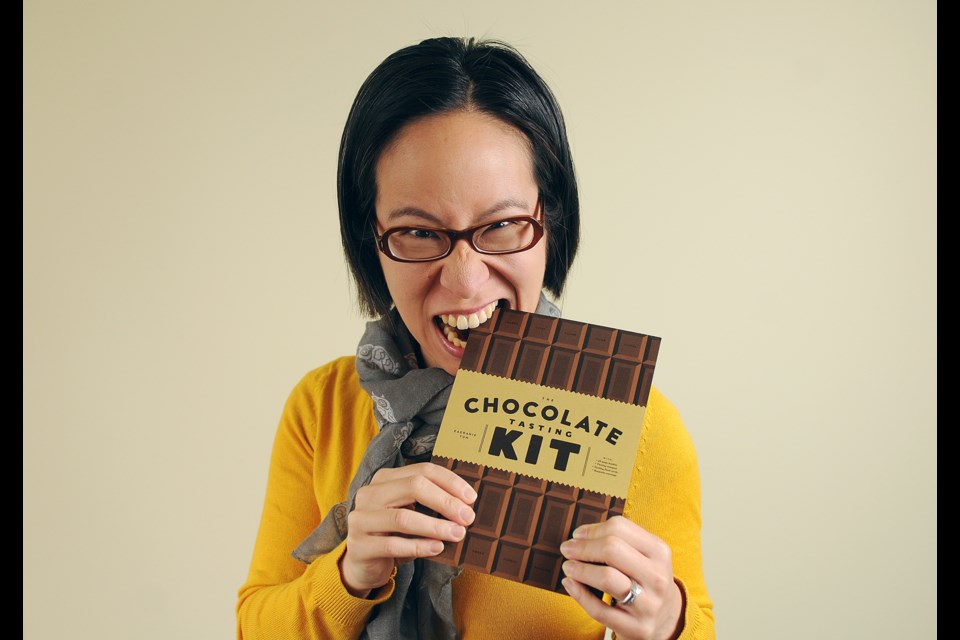The Courier’s Sweet Spot columnist Eagranie Yuh is a bit of a chocolate aficionado. Yuh first caught our attention dishing out sharp and witty dispatches on her blog . She also teaches chocolate tasting classes in Â鶹´«Ă˝Ół»and Seattle and is a regular speaker on the subject of chocolaty goodness. Maybe it’s all that sugar, but Yuh found time to write The Chocolate Tasting Kit, released this month by San Francisco’s Chronicle Books. Not your average book, it’s exactly what it claims to be: a stylish looking kit, in the shape of an oversized chocolate bar, consisting of a 48-page booklet, 100-sheet tasting notepad, 12 tasting flash cards and a keepsake envelope for chocolate wrappers. Yuh hosts a “chocolate tasting party” at Barbara-Jo’s Books to Cooks, April 1, 6:30 to 8 p.m (details at ). But before all that, she talked with the Courier about Vancouver’s chocolate scene, her dislike of Reese’s peanut butter cups and the importance of “meltiness.” Â
1. Where did your love of chocolate originate?
I’ve always loved chocolate, but I took it further than most people. I have a science background and ended up at culinary school, training to be a pastry chef. While I dreamed of cakes, I ended up loving chocolate. Kitchen life wasn’t a good fit for me, so I started looking into the science of chocolate. That led me to attend conferences in the chocolate industry and having insanely geeky conversations about crystallization and fermentation, packaging and marketing. I found my tribe.
2. How does one become a “chocolate expert”?
I wish I knew. I learned by teaching, and I learned by making a lot of mistakes. Over the years, I’ve met most of the chocolate makers in North America, and a lot of the ones in the world. I never meant to do that; it just sort of happened. And when you meet so many chocolate makers, you taste a lot of chocolate. Of course, the simpler answer is that I taste a lot of chocolate. I taste it like sommeliers taste wine, though I rarely spit my chocolate out. I taste it analytically and quietly and by making strange faces, but really my brain is trying to sort out all the flavours and aromas and textures.
3. What are some misconceptions people have about chocolate?
There are too many to cite, but the one that gets me is this idea that chocolate is a health food and that this is a compelling reason to eat it. I eat things because they taste good, and eating them gives me pleasure and enjoyment, and for the most part I refrain from cramming food in my mouth indiscriminately. (Notable exceptions: Cool Ranch Doritos and Oreo cookies, neither of which are allowed in my house.) Sure, chocolate is good for you, but most things are in moderation. If you need an excuse to indulge in chocolate, then I won’t revoke that excuse. But if your sole reason for eating a square of dark chocolate is because you believe it’s good for your heart, then I implore you to actually taste and enjoy it.
4. What is one of the more mind-blowing facts you can tell us about chocolate?
Chocolate is a universal tool for teaching. It has elements of agriculture, sustainability, geography, chemistry, physics, mechanical engineering, gastronomy and culinary artistry. I’ve taught nine-year-olds about science and adults about agriculture — all because they wanted to learn about chocolate.
5. Unlike a lot of food, chocolate really crosses all cultures, demographics, incomes. Why do you think that is?
I think it’s because chocolate is so accessible. You can be a kid and eat a grocery store bar or waxy Easter eggs, or you can be a connoisseur with single-origin bars from exclusive shops. There’s something for everyone. However, I will point out that there’s not much of a chocolate culture in hot climates, notably China and India, and that chocolate companies are desperately tinkering with chocolate to try to get into these markets. But mostly that tinkering means making chocolate that doesn’t melt as easily, which is not only creepy but makes it less nice to eat. That meltiness is a big part of the experience.
6. I know you normally deal with quality chocolate, but if you’re at a corner store eyeing up the commercial chocolate bar rack, what are you reaching for?
Twix. Because there are two in a package so I don’t have to fight my husband for one, and because it hardly qualifies as a chocolate bar. It’s more about the texture: the crumbly cookie, the chewy caramel, the faux-chocolate coating that offers a bit of a creamy element.
7. What’s one chocolate bar that you can’t stomach?
I tried eating a Reese’s peanut butter cup the other day, because I remembered really liking them. It tasted like a crayon.
8. How does Vancouver’s chocolate scene compare to others?
Â鶹´«Ă˝Ół»has a phenomenal chocolate scene. Everyone’s doing something different, and for the most part, doing it well. I took a trip to Europe last fall and tasted chocolate all over Belgium, France and England. I was really impressed with how Vancouver’s chocolate held up — and in many cases was superior.
9. How much chocolate do you eat in a week?
I probably eat about a 100-gram bar per week. On a stressful week, I might eat two or three times that.
10. Can one get a chocolate hangover and have you ever suffered from one?
Yes and yes. I organized the International Chocolate Awards, Canada national competition last year. The first day of judging is a screening round. Seven other judges and I had to taste every single entry — we had more than 100 — and by the end of it I was high from the sugar, buzzing from the chocolate, and sick to my stomach. The next morning I felt wretched, but the first judging round started shortly afterward and the hair of the dog seemed to help.



